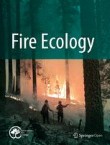Introduction
For nearly two decades, Fire Ecology and the Association for Fire Ecology have worked towards the mission of improving the knowledge of fire ecology and uses of fire in resilient landscape management.
What started as a trailblazing journal in 2005 has grown to a top-tier wildfire science journal. Therefore, we would like to take this opportunity to celebrate and reflect on the progress and achievements Fire Ecology has made with the unwavering support of its editorial board members, reviewers and authors over the years; and to share what our priorities are for the future.
The following are highlights of topics that are important to Fire Ecology that we feel may be of particular interest to its readers and authors:
Gender Balance and Geographical Diversity of our Editorial Board is Top Priority
Nearly half of the Fire Ecology Editorial Board are women. While we are especially proud of the gender balance of the board, we also acknowledge that we still have work to do to ensure the board is fully reflective of the research community it serves.
Since North America is well represented in our Editorial Board, we seek recommendations and self-nominations from Editors who might wish to join from Africa, Asia, Australia, Europe, and Latin America.
Spanish Translation of Abstracts Expand Our Readership Worldwide
Since its inception, Fire Ecology offers Spanish translations of abstracts to increase its readership in Central America, South America, and Europe. This voluntary service was made possible by a team of passionate Spanish-speaking fire ecologists and scientists in Argentina headed by Guillermo E. Defossé.
However, since the number of published articles in Fire Ecology has increased, this invaluable translation service now requires a significant amount of time. As of August 2023, the Association for Fire Ecology (AFE)—a registered 501c3 non-profit organization—will pay translators for their contributions. To support AFE's ability to continue providing Spanish translations for abstracts, please consider donating to AFE at https://fireecology.org/donate.
Collections that Reflect the Editorial Development of the Journal
As Fire Ecology evolves to reflect growing and expanding areas of ecology and forestry, collections provide a great way to showcase the work of others on related topics. You are welcome to explore the full list of Fire Ecology collections here.
A special mention goes to the Fire Ecology Chats collection of podcasts that discuss the origins, results, and implications of papers published in the journal.

If you have a specific topic of interest you would like to see covered in Fire Ecology, please contact the Editors of the journal using this form.
From article views to impact, research published in Fire Ecology is getting noticed…
Since 2021, articles published in Fire Ecology have been accessed well over 250,000 times per year, more than double the average number of annual article accesses in prior years. We attribute this largely to the increasing interest in fire ecology as a field, and also to the increased citations and use of the journal by the research community. This is also reflected in the journals most recent Impact Factor of 5.34, which is nearly double the Impact Factor of the previous year. While the Impact Factor is not the only measure of a journal’s success, we think this shows a strong indication of the growing interest and impact of research findings published in Fire Ecology.
This is also evident in the Altmetrics of the articles publishing in the journal, more information which can be found below.
Thanks to all those who reviewed for Fire Ecology
A peer-reviewed journal would not survive without the generous time and insightful comments of the reviewers, whose efforts often go unrecognized. Although final decisions are always editorial, they are greatly facilitated by the deeper technical knowledge, scientific insights, understanding of social consequences, and passion that reviewers bring to our deliberations.
The Editors of Fire Ecology would like to thank warmly the reviewers whose comments helped to shape the journal, for their invaluable assistance with review of manuscripts.
Get Involved!
Are you interested in support research in wildfire research? From ideas for collections to Editorial Board nominations and reviewer referrals, we very much value and welcome your input!
Please feel free to contact us should you wish to share feedback or any ideas you have for the journal.
